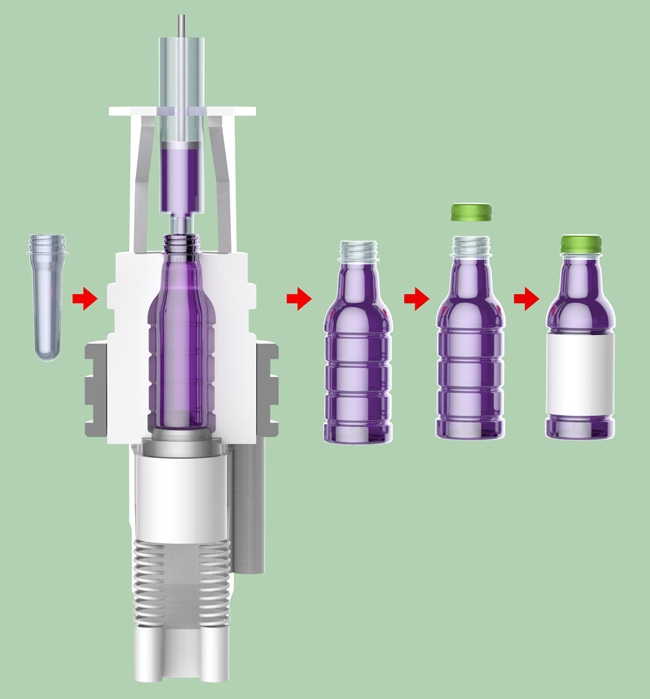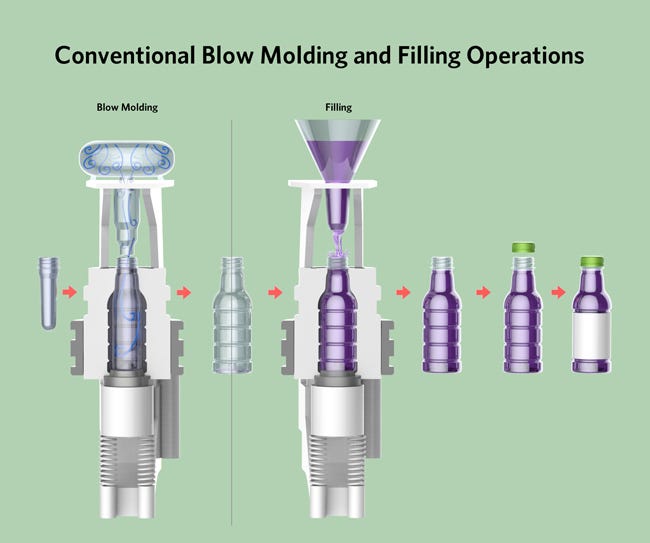New technology in blow molding bottles doesn't come along every day, which is why when something revolutionary is brought to the forefront, industry takes notice. LiquiForm (Ann Arbor, MI) has introduced what it calls a breakthrough blow molding and filling manufacturing technology that promises to bring significant energy and cost savings, as well as other benefits, to liquid packaging producers worldwide.
August 15, 2014

New technology in blow molding bottles doesn't come along every day, which is why when something revolutionary is brought to the forefront, industry takes notice. LiquiForm (Ann Arbor, MI) has introduced what it calls a breakthrough blow molding and filling manufacturing technology that promises to bring significant energy and cost savings, as well as other benefits, to liquid packaging producers worldwide.
By using a consumable, pressurized liquid instead of compressed air to form plastic containers, LiquiForm technology combines the bottle forming and filling processes into one step. Ann O'Hara, President of LiquiForm, commented to PlasticsToday that the industry has been heading in this direction over time. "There is already the trend of connecting the blower and filler, which got us closer but that was still two steps, not just one." The actual birth of this technology began in brain-storming sessions in 2004 and 2005, in a drive toward simplification and cost savings by "thinking more innovatively," O'Hara explained. "A few people came up with the idea but like many innovative ideas, it required the equipment to make the technology work. Initially, they took an old machine and retrofit it using spare parts to accommodate the technology at an Amcor facility," she said. "To their great pleasure, they got it to work. To accomplish this, they had to trick the system into thinking it had air in it, not liquid, to get it to run. Amcor then invited others to participate and ultimately initiated a joint venture with Sidel and a development agreement with Yoshino to help."
The actual birth of this technology began in brain-storming sessions in 2004 and 2005, in a drive toward simplification and cost savings by "thinking more innovatively," O'Hara explained. "A few people came up with the idea but like many innovative ideas, it required the equipment to make the technology work. Initially, they took an old machine and retrofit it using spare parts to accommodate the technology at an Amcor facility," she said. "To their great pleasure, they got it to work. To accomplish this, they had to trick the system into thinking it had air in it, not liquid, to get it to run. Amcor then invited others to participate and ultimately initiated a joint venture with Sidel and a development agreement with Yoshino to help."
Patent filings revealed that other companies were thinking about this technology, as well, including Nestle Waters, one of the world's leading bottled water companies. Very recently the joint venture acquired its complementary intellectual property for this innovative technology.
 O'Hara explained that the JV is separate from both Amcor, a multinational packaging leader, and Sidel, a global provider of PET solutions for liquid packaging. The JV allows the engineering team the time, workspace, and money to take the risks required when bringing a new technology to the marketplace, she noted. "We want this to be an industrywide effort, but there will be changes to every participant's business model that are not always predictable at the beginning of the journey. In the beginning, it took a handful of passionate engineers with a great idea and not many restrictions. This technology is different and difficult, and while some could only see the problems [of this technology], they saw the opportunity."
O'Hara explained that the JV is separate from both Amcor, a multinational packaging leader, and Sidel, a global provider of PET solutions for liquid packaging. The JV allows the engineering team the time, workspace, and money to take the risks required when bringing a new technology to the marketplace, she noted. "We want this to be an industrywide effort, but there will be changes to every participant's business model that are not always predictable at the beginning of the journey. In the beginning, it took a handful of passionate engineers with a great idea and not many restrictions. This technology is different and difficult, and while some could only see the problems [of this technology], they saw the opportunity."
LiquiForm technology has been validated with a significant range of packaging substrates including PE and HDPE, as well as products and conditions using the same LiquiForm machine for cold, ambient, and hot-fill containers. "We're endeavoring to use a wide range of liquids, including water and soft drinks, and now we're using more viscous materials," stated O'Hara. "Some [products] will be easier to move into this application than others, but we're confident that the first commercial application will be in two to three years."
Currently, the JV has six machines over the four companies working on the technology; next year, LiquiForm will invite more equipment companies to participate and bring in brand owners to work with the technology either at LiquiForm's site or their own.
LiquiForm Group is now actively seeking additional commercial partners, and the technology will be widely available through licensing and royalty systems, which encourage partners and licensees to invest in future innovation and development.
"It will be a great value to the brand owners," said O'Hara. "The sustainability benefits will be huge. Blowing air into a bottle uses a lot of energy. With liquid being incompressible, it makes a more precise definition of the bottle while allowing for lightweighting, as well."
O'Hara added that this is not only innovative as a technology but as a business model, as well. "We believe this will become a true industry standard that can achieve its full potential with everyone participating," she said.
For a virtual video of the technology, go to the How It Works tab at www.liquiformgroup.com.
About the Author(s)
You May Also Like




